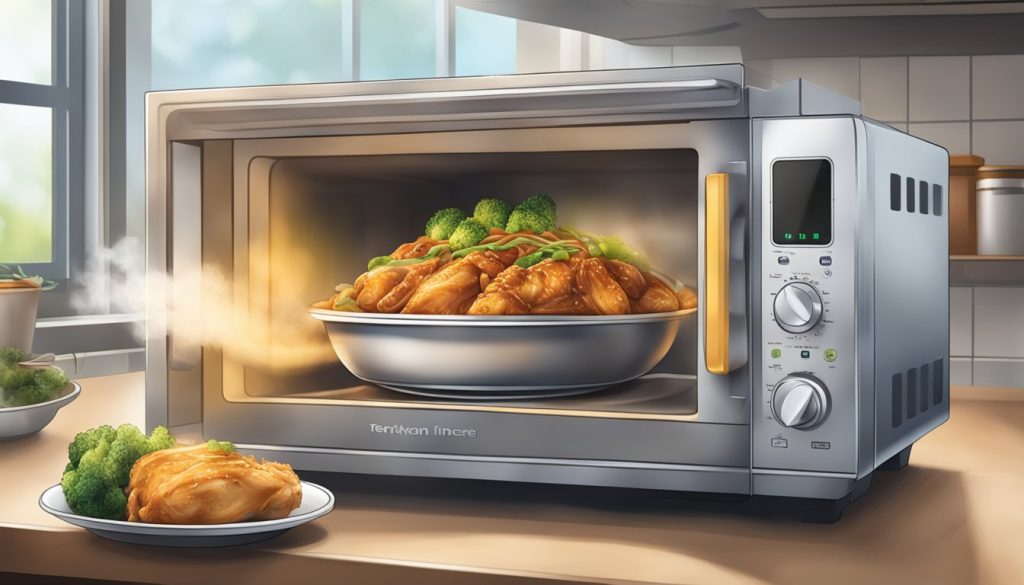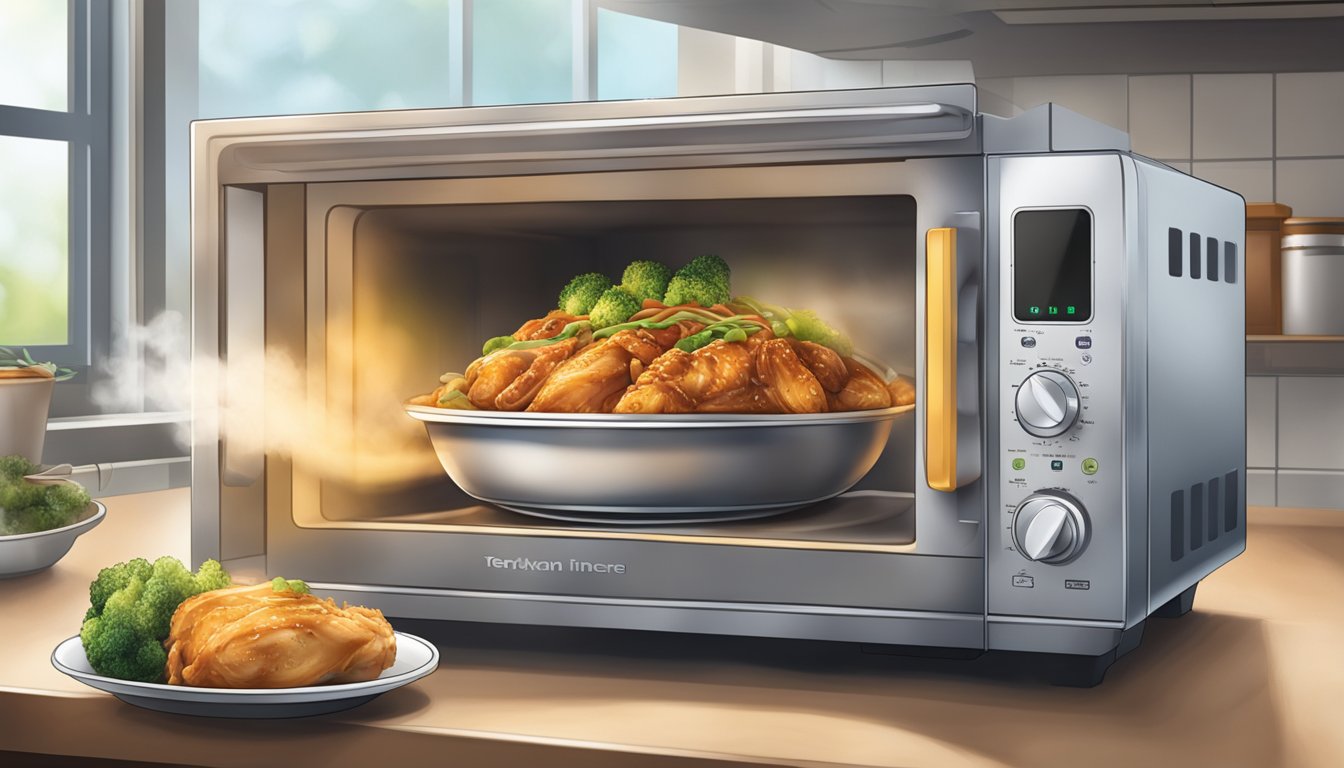Reheating chicken teriyaki bowls doesn’t have to result in dry, flavorless leftovers. With the right techniques, you can enjoy a meal that tastes just as delicious as when it was first prepared. The key to successfully reheating chicken teriyaki is maintaining moisture while ensuring even heat distribution.

Several methods can effectively reheat chicken teriyaki while preserving its flavor and texture. These include using a microwave, stovetop, oven, or air fryer. Each approach offers unique benefits, allowing you to choose the best option based on available time and desired outcome.
Proper reheating not only restores the dish’s temperature but also helps retain the savory teriyaki glaze and tender chicken texture. By following expert tips, anyone can master the art of reheating chicken teriyaki bowls to near-original quality.
Understanding Chicken Teriyaki

Chicken teriyaki combines tender chicken with a flavorful glaze of soy sauce, mirin, and sugar. This popular dish offers a balance of sweet and savory notes, making it a versatile option for various meals.
The Composition of Chicken Teriyaki
Chicken teriyaki consists of grilled or pan-fried chicken coated in teriyaki sauce. The sauce typically includes soy sauce, mirin (sweet rice wine), sugar, and sometimes ginger and garlic. Some recipes incorporate cornstarch to thicken the sauce.
The chicken is usually cut into bite-sized pieces or left as whole breasts or thighs. It’s often marinated in the sauce before cooking to enhance flavor penetration.
Teriyaki sauce can be store-bought or homemade. A basic homemade version combines:
- 1 cup soy sauce
- 1 cup water
- 1/2 cup sugar
- 1/4 cup honey
- Minced garlic and grated ginger
These ingredients are simmered until the sugar dissolves and the sauce thickens slightly.
Storing Leftover Chicken Teriyaki
Proper storage of leftover chicken teriyaki is crucial for maintaining its quality and safety. After cooking, allow the dish to cool to room temperature, but don’t leave it out for more than two hours.
Store the chicken teriyaki in an airtight container in the refrigerator. It will keep for 3-4 days when refrigerated properly. For longer storage, chicken teriyaki can be frozen for up to 3 months.
When freezing, separate the chicken and sauce if possible. This helps preserve the texture of the chicken upon reheating. Label the container with the date to track freshness.
To thaw frozen chicken teriyaki, move it to the refrigerator the night before intended use. This slow thawing method helps maintain the dish’s quality.
Preparing for Reheating
Proper preparation is key to successfully reheating chicken teriyaki bowls. Ensuring the dish is safely thawed and having the right tools on hand will lead to better results.
Thawing Frozen Chicken Teriyaki
If the chicken teriyaki bowl is frozen, it must be thawed before reheating. The safest method is to move it from the freezer to the refrigerator. This slow thawing process typically takes 24 hours for a standard portion.
For quicker thawing, use the microwave’s defrost setting. Place the frozen dish in a microwave-safe container and defrost in short intervals, checking frequently. Rotate the dish for even thawing.
Avoid thawing at room temperature, as this can promote bacterial growth. Once thawed, consume the chicken teriyaki within 1-2 days for best quality and safety.
Gathering the Necessary Tools
Collect the appropriate tools before reheating chicken teriyaki. A microwave-safe dish or an oven-safe dish is essential, depending on the chosen reheating method.
A food thermometer is crucial for checking the internal temperature of the reheated chicken. It should reach 165°F (74°C) to ensure food safety.
For stovetop reheating, gather a non-stick pan and a spatula or tongs. If using an oven, have aluminum foil ready to cover the dish and prevent drying.
A small bowl of water and a clean kitchen towel can be helpful for adding moisture during reheating if needed.
Reheating Methods
Chicken teriyaki bowls can be easily reheated using several effective methods. Each approach offers unique benefits for restoring the dish’s flavors and textures.
Microwave Reheating
Place the chicken teriyaki bowl in a microwave-safe container. Cover with a microwave-safe lid or plastic wrap, leaving a small vent for steam to escape. Heat on medium power for 1-2 minutes.
Stir the contents and check the temperature. If needed, continue heating in 30-second intervals until thoroughly warmed. Let the bowl rest for 1 minute before serving.
For even heating, arrange the chicken pieces in a circle around the edge of the container. This helps prevent cold spots in the center.
Oven Reheating
Preheat the oven to 350°F (175°C). Transfer the chicken teriyaki bowl to an oven-safe dish. Cover tightly with aluminum foil to retain moisture.
Heat for 15-20 minutes, or until the internal temperature reaches 165°F (74°C). For crispier chicken, remove the foil during the last 5 minutes of heating.
Stir the contents halfway through to ensure even warming. Let the dish cool for 2-3 minutes before serving.
Stovetop Reheating
Heat a non-stick skillet over medium heat. Add a small amount of oil or cooking spray to prevent sticking. Place the chicken teriyaki in the pan.
Cover the skillet with a lid to trap steam and heat evenly. Cook for 5-7 minutes, stirring occasionally. Add a splash of water or teriyaki sauce if the dish seems dry.
For best results, separate the chicken from the rice and vegetables. Heat the components individually, then recombine before serving.
Air Fryer Reheating
Preheat the air fryer to 375°F (190°C). Place the chicken pieces in the air fryer basket, ensuring they don’t overlap. Cook for 3-4 minutes, shaking the basket halfway through.
Heat the rice and vegetables separately in the microwave or on the stovetop. This prevents overcooking and maintains optimal texture.
For extra crispiness, lightly spray the chicken with cooking oil before air frying. Let the chicken rest for 1-2 minutes before combining with the other ingredients.
Ensuring Quality and Safety
Properly reheating chicken teriyaki bowls requires attention to temperature and moisture retention. These factors are crucial for both food safety and preserving the dish’s flavor and texture.
Checking the Internal Temperature
Use a food thermometer to verify the internal temperature of reheated chicken teriyaki reaches 165°F (74°C). This ensures any harmful bacteria are eliminated.
Insert the thermometer into the thickest part of the chicken. Avoid touching bone or the container, as this can give inaccurate readings.
If the temperature is too low, continue reheating in short intervals. Check again after each interval to prevent overcooking.
For even heating, stir the contents of the bowl halfway through reheating. This helps distribute heat more uniformly throughout the dish.
Retaining Moisture and Flavor
Cover the chicken teriyaki bowl when reheating to trap steam and prevent moisture loss. Use a microwave-safe lid or damp paper towel for microwave reheating.
Add a small amount of water or chicken broth before reheating to replenish moisture. This helps maintain the juiciness of the chicken and prevents drying out.
Reheat at a lower temperature for a longer time to preserve texture. High heat can cause uneven cooking and toughen the meat.
Drizzle a small amount of teriyaki sauce over the reheated dish to refresh the flavor. This compensates for any flavor loss during the reheating process.
Avoid reheating chicken teriyaki multiple times, as this can degrade quality and increase food safety risks.
Reheating Tips and Best Practices
Avoid overheating chicken teriyaki bowls to prevent dryness. Reheat in small portions or batches for even heating and better texture retention.
Use a sauce or broth to add moisture during reheating. This helps maintain the dish’s flavor and prevents the chicken from becoming tough.
When using a microwave, cover the bowl with a damp paper towel. Heat in 30-second intervals, stirring between each, until the desired temperature is reached.
For oven reheating, preheat to 350°F (175°C). Place the bowl in an oven-safe dish, add a splash of water or sauce, and cover with foil. Heat for 10-15 minutes.
Stovetop reheating works well for larger portions. Use a non-stick pan over medium heat, add a small amount of oil, and stir frequently for 5-7 minutes.
An air fryer can crisp up the chicken while reheating. Set to 375°F (190°C) and cook for 3-4 minutes, shaking the basket halfway through.
Recommended cooking times:
| Method | Time | Temperature |
|---|---|---|
| Microwave | 1-2 minutes | High |
| Oven | 10-15 minutes | 350°F (175°C) |
| Stovetop | 5-7 minutes | Medium heat |
| Air Fryer | 3-4 minutes | 375°F (190°C) |
Always check the internal temperature of reheated chicken reaches 165°F (74°C) for food safety.
Finishing Touches

Adding the final touches to your reheated chicken teriyaki bowl elevates the dish from a simple leftover to a restaurant-quality meal. These small details can make a big difference in both flavor and presentation.
Adding Fresh Garnishes
Sprinkle sesame seeds over the reheated chicken teriyaki for a nutty crunch and visual appeal. White or black sesame seeds work well, adding contrast to the dish. Finely chopped green onions provide a fresh, crisp texture and a mild onion flavor that complements the sweet and savory teriyaki sauce.
For added color and nutrition, consider adding thin slices of cucumber or shredded carrots. These fresh vegetables offer a cool crunch that balances the warm chicken. A small handful of crisp bean sprouts can also add texture and a subtle earthy flavor to the bowl.
Serving and Presentation
Serve the reheated chicken teriyaki in a wide, shallow bowl to showcase all the components. Arrange the chicken and vegetables neatly, creating an appealing visual composition. Place the chicken in the center, surrounded by any reheated vegetables or rice.
Drizzle extra teriyaki sauce over the chicken or serve it on the side for those who prefer more flavor. For a professional touch, use a small dish of sauce as part of the presentation. Garnish with a sprinkle of sesame seeds and chopped green onions just before serving to maintain their fresh appearance and texture.
Consider adding a wedge of lemon on the side. The acidic notes can brighten the flavors of the dish and cut through the richness of the teriyaki sauce.
